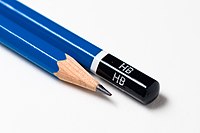
Photo from wikipedia
Poetry writing is a qualitative subject and so is its analysis. Mapping of these poetic elements onto a scale of real numbers is a lacking necessity. Albeit, Hindi literary heritage,… Click to show full abstract
Poetry writing is a qualitative subject and so is its analysis. Mapping of these poetic elements onto a scale of real numbers is a lacking necessity. Albeit, Hindi literary heritage, being so huge and glorified, there is remarkably very few computational works done exploring the underlying structures. Out of which most of them is to detect a particular metre rather than a generalized approach. The state-of-art metadata generator fails to provide any measures of underlying structural elements of poetry. There is no automated system that generates rhyming pattern hidden in a poem for Hindi language or a system to detect and estimate the extent of figure of speech in a given text of any language. In this article, to extract and evaluate elements of poetry, three efficient tools, namely Text2Mātrā, RPaGen and FoSCal, have been designed and developed. The Text2Mātrā tool provides the numeral scansion for any Hindi input text, which can serve as basis for copious analytical and detection work. RPaGen detects the poem type of any input poem and outputs its rhyming pattern. FoSCal gives a quantitative representation of detected figures of speech in any input text, using the scoring scheme formulated using fuzzy approach and weighted analysis. These tools may find their utility in various fields such as education, literary criticism, philology, authorship-attribution, etc. There have been various computational activities done in the field of poetry analysis over the various languages across the world. However, quantifying the extent of Figure of Speech in poetic compositions, in any language, is entirely a novel approach. Mapping the aesthetic properties of a subjective idea (like poetry) onto a numeral scale, to the best of our knowledge, is first of its kind for Hindi language.
Journal Title: IEEE Access
Year Published: 2022
Link to full text (if available)
Share on Social Media: Sign Up to like & get
recommendations!